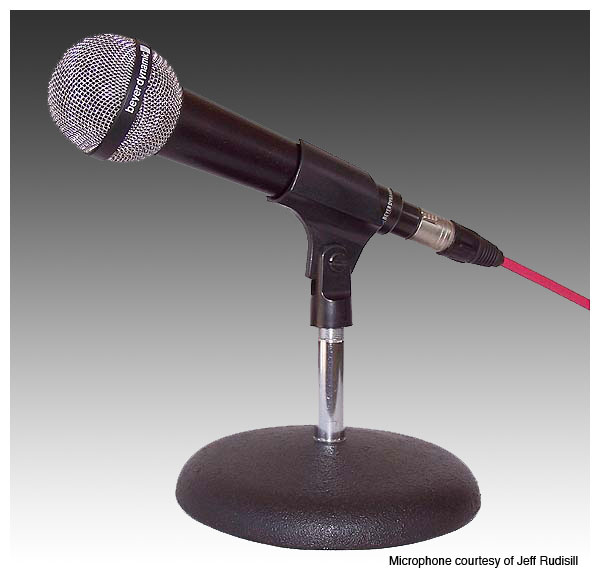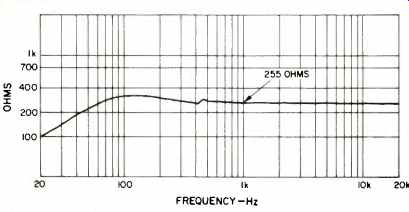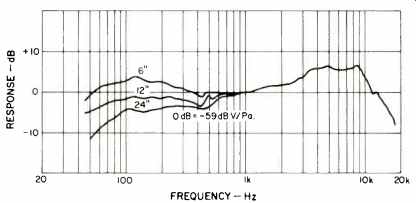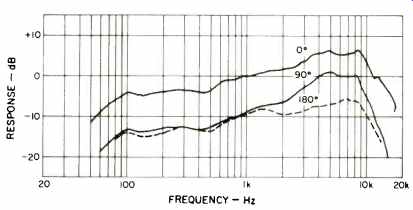
MANUFACTURER'S SPECIFICATIONS:
Operating Principle: Pressure gradient.
Frequency Response: 40-18,000 Hz within 2.5 dB of nominal curve; individual chart record supplied with each microphone.
Polar Pattern: Hypercardioid (also known as "supercardioid"). Output Level @ 1 kHz: Open Circuit Voltage: 0.9 mV/Pa (-60 d By/Pa).
Power Sensitivity: -60 dBm.
EIA Sensitivity Rating:-153 dB. Electrical Impedance: 200 ohms.
Load Impedance: 1000 ohms, min.
Diaphragm (Ribbon); Pure aluminum, 21.6 mm (0.85 in.), weight, 0.34 milligrams.
Case: Aluminum.
Case Finish: Matte black anodized (aluminite process ).
Dimensions: 7.44 in. (18.9 cm) L x 2.22 in. (5 65 cm) x 0.95 in. (2.4 cm) conical shaft diameter.
Net Weight (Less cord): 8.5 oz. (240 grams).
Built-in Male Connector: Switchcraft M3M, or equivalent.
Special Features: Integral windscreen and a four-stage "pop" and blast filter.
Swivel Mount: MKV6 Quick release clamp supplied.
Cable: MVK N(C), 42cm (16.5 in.), 2 conductor shielded, black rubber jacket. Switchcraft A3F connector on microphone end.
Price: $169.95 with leatherette carrying case. There are a full line of optional accessories available such as gooseneck, table and floor stands, and cable transformers.
Note: Specifications are listed for the 200-ohm model, but a 500-ohm model 89 is also available.
- - - -
The M500N (C) is a unidirectional ribbon microphone with a rising frequency response characteristic, and thus is a good choice for "pop" vocalists and instruments. A detailed selection chart, available from Beyer, lists 24 applications for which the M500N has "outstanding performance," plus an additional 24 for which it has "good performance." The list includes banjo, guitar, sitar, and theorbo (which the cognoscente will recognize as a double-necked form of lute for which no music has been written since 1732.) This is the most detailed application data we've seen on microphones, and we appreciate the effort Beyer has made to ensure correct application of their products.
Many English-speaking readers may be confused by the association of the trade name Beyerdynamic with a ribbon mike. We were surprised to find that this "stick and ball" microphone, prominently marked Beyerdynamic, contains a ribbon transducer. The justification for this apparent contradiction is that both ribbon and moving-coil transducers operate by the electrodynamic principle, where voltage is induced into a conductor that is moving in a magnetic field.
From the Beyer literature, we learn that they have been making microphones for about a half-century. However, until very recently, Beyer microphones were relatively little known in the U.S., and our old catalog sheet on the M500 (three to five years old) shows it was available only with a Tuchel connector. Now, the line has been Americanized with Cannon-type connectors and quite readable English language data sheets. At present, Beyer microphones, headsets, transformers, and accessories are being actively marketed in the U.S. by Hammond Industries.
Most of the Beyer ribbon microphones have flat frequency response characteristics and are best suited to applications with high-grade audio components that include variable equalizers. The tailored, rising response of the M500N eliminates the need for external equalizers for the pickup of "pop" vocal and instrumental music. The response characteristic is also suited to high intelligibility speech reproduction in sound reinforcement systems.
The specifications include some parameters of the Beyer ribbon. Having designed some RCA ribbon microphones, we were able to make some comparisons. The Beyer ribbon is 21.6 mm long and weighs 0.34 mg, while the RCA BK-5B ribbon is 25.4 mm long and weighs 0.2 mg. The difference in mass is not the significant point, as high electro-acoustic efficiency requires a narrow range of foil thickness in order to match the air load. The significant difference is that Beyer, using a ribbon of similar size, has developed a magnetic structure and acoustical resistance termination of greatly reduced size and weight compared to the RCA mike. The sensitivity of the M500N is only 3 dB less than the BK-5B. The blast filter feature of the M500N, which is said to protect the ribbon from breath blast, is not new. (The BK-5B has a filter which, tests have shown, protects the ribbon from the blast of .38 caliber blank cartridges.)

Fig. 1-Impedance of the Beyerdynamic M500N(C) microphone.

Fig. 2-Frequency response vs. distance.

Fig. 3-Frequency response vs. angle.
Laboratory Tests
Figure 1 is the impedance vs. frequency curve. Ribbon resonance is about 130 Hz, and the familiar "third harmonic" is about 450 Hz. Good response is obtainable to about an octave below the fundamental resonance, as shown in Fig. 2.
The high resonance of the M500N makes it more suited to voice or other than bass instruments. The literature hints that this mike has less proximity effect than other unidirectional mikes. The curves of Fig. 2 show that the Beyer will sound just as "boomy" as the others at close distances. This problem is not severe because Beyer has adjusted the distant response (see 24-in. curve) to be rising at a rate of about 5 dB per decade of frequency. We immediately noticed that the M500N is similar in the voice range to the Shure 548, 565, etc. series. These Shure mikes are favored for their clarity on vocalists, and the M500N should be equally as good.
However, the M500N has more response in the lowest and highest octaves, compared to Shure, so it will be superior on certain high- and low-pitched instruments. Of course, you must pay more to obtain this performance. Note that the frequency response curves have a "glitch" at the ribbon harmonic of 450 Hz. This is characteristic of ribbon transducers, even though this sometimes smoothes out with age.
Our 24-in. curve agrees with the curve supplied with the microphone, ± 1 dB above 1000 Hz and ± 2 dB below 1000 Hz. We are pleased with this excellent correlation with a foreign lab. (Following a recent review of a Shure mike, we conducted a correlation test and found we agree ± 1 dB with their lab.) The directional frequency response curves are shown in Fig. 3. These compare favorably to the published polar response graph. The hyper- or super-cardioid is characterized by a null at 120° to 135°, but we were content merely to check 90° and 180°. From 0° ±90°, the pattern is essentially independent of frequency, so there will be little change in sound quality within the useful pickup angle of 0 ° ±45 °. (A cardioid mike has a useful range of 0° ± 60°.) The hyper cardioid is ideal for the pickup of one or two vocalists. Where the loudspeakers are placed to the side, feedback will be less of a problem than with a cardioid. For pickup of larger groups of vocalists or instruments, a cardioid is to be preferred. Our experience with figure-eight (bidirectional) microphones, which have a 90° pickup angle, is that sometimes individual talkers or vocalists will position themselves more than 45° off axis, resulting in a low audio level.
It should be noted that ribbon transducers have asymmetrical directional characteristics. In the plane normal to the ribbon, the pattern is superior at high frequencies to a transducer with a round diaphragm. In the plane of the ribbon, the pattern is degraded at high frequencies, similar to a round diaphragm of equivalent dimension. Most ribbon mikes are designed to be used with the ribbon vertical because most sound sources are disposed in the horizontal plane. Beyer gives no clue as to the plane of the ribbon in the M500N, so it's possible the user might noticeably improve the off-axis sound by rotating the mike.
Hum sensitivity is as low as our BK-5B, and this should be no problem with the M500N. The wind and "pop" sensitivity was slightly greater than with the BK-5B, though in order to obtain this result we used a large four-inch diameter windscreen on the BK-5B. Vibration noise was a little greater with the M500N than with the BK-5B, but much less than a Shure 548, for example.
Dynamic moving-coil cardioids have exceedingly high vibration sensitivity due to the "seismic" effect on the massive coil and diaphragm. For many applications, this feature alone may justify the purchase of the Beyer mike.
Phasing is pin 2 positive, in agreement with the proposed EIA revised standard.
The anodized finish is hard and durable, but will show scuff marks. The "ball" is much less rigid than that of the Shure 565-SD, and can be deformed by finger pressure. The spring-mounting clip is poor and has no threaded metal insert with the stand. The swivel from the Shure 548 works very well, and the user is advised to use this swivel.
It is very important to use caution when checking continuity of the mike cabling-ribbons are usually destroyed by the d.c. current pulse of most ohmmeters.
Listening & Subjective Tests
The M500N sounded much crisper on voice than our BK-5B with V2 (voice) compensation, and it sounded identical to a Shure 548 mike. A 4-dB higher gain was needed to match the Beyer to either of the comparison mikes.
Only pop music was used for testing. The Beyer sounded more "tipped up," "present," or "brighter" than the BK-5B (M) (without voice rolloff). The M500N sounded similar to the Shure 548, except more overtones of strings were heard.
Sometimes high-frequency distortion and noise, as from recorded sources, would be reproduced by the Beyer's extended response, though this would be filtered out by the more restricted response of the Shure.
For many less critical voice and pop music applications, the Beyer has no performance advantage compared to the much less expensive moving-coil cardioid mikes, such as the Shure 548 or 565 SD. However, the M500N (C) is an excellent choice for more demanding applications and for any pop application where economics permit the choice of a high-grade mike. Many professionals will welcome the availability of a ribbon in a pop musician style package.
(Source: Audio magazine, Feb. 1978, by Jon R. Sank)
= = = =